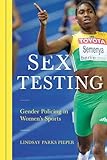Sex testing : gender policing in women's sports / Lindsay Parks Pieper.
Material type: TextSeries: Publication details: Urbana : University of Illinois Press, (c)2016.Description: 1 online resource (x, 250 pages) : illustrationsContent type:
TextSeries: Publication details: Urbana : University of Illinois Press, (c)2016.Description: 1 online resource (x, 250 pages) : illustrationsContent type: - text
- computer
- online resource
- 9780252098444
- GV709 .S498 2016
- COPYRIGHT NOT covered - Click this link to request copyright permission: https://lib.ciu.edu/copyright-request-form
| Item type | Current library | Collection | Call number | URL | Status | Date due | Barcode | |
|---|---|---|---|---|---|---|---|---|
 Online Book (LOGIN USING YOUR MY CIU LOGIN AND PASSWORD)
Online Book (LOGIN USING YOUR MY CIU LOGIN AND PASSWORD)
|
G. Allen Fleece Library ONLINE | Non-fiction | GV709 (Browse shelf(Opens below)) | Link to resource | Available | ocn936205674 |
Browsing G. Allen Fleece Library shelves, Shelving location: ONLINE, Collection: Non-fiction Close shelf browser (Hides shelf browser)
"In 1968, the International Olympic Committee (IOC) implemented sex testing for female athletes at that year's Games. When it became clear that testing regimes failed to delineate a sex divide, the IOC began to test for gender --a shift that allowed the organization to control the very idea of womanhood. Lindsay Parks Pieper explores sex testing in sport from the 1930s to the early 2000s. Focusing on assumptions and goals as well as means, Pieper examines how the IOC in particular insisted on a misguided binary notion of gender that privileged Western norms. Testing evolved into a tool to identify--and eliminate--athletes the IOC deemed too strong, too fast, or too successful. Pieper shows how this system punished gifted women while hindering the development of women's athletics for decades. She also reveals how the flawed notions behind testing--ideas often sexist, racist, or ridiculous--degraded the very idea of female athleticism"--
"To assess the long-lasting significance of sex testing in sport, this book explores its history, from the 1930s to the early 2000s, with particular emphasis on the International Olympic Committee's mandated compulsory sex checks on all female competitors. In 1968 the Medical Commission implemented the first test of the modern Olympic Movement. The procedure intended to guarantee the authenticity of Olympic competitors and identify male masqueraders, as well as to scientifically confirm the separation of men and women in athletic competition. Although the Medical Commission never discovered a single male imposter, and the test illustrated the impossibility of determining the exact constitution of woman, the IOC maintained the policy for three decades. With both the impossibility of discovering a clear sex divide and the increased presence of female dopers, the IOC adjusted its semantic framework to encapsulate gender normativity. The conspicuous adjustment from sex to gender underscored the Medical Commission's changing anxieties. Rather than to catch men disguised as women, the test evolved into a measure to preclude female Olympians with biological advantages. In other words, the Medical Commission eventually viewed gender verification as a tool to eliminate competitors it deemed too strong, too fast or too successful for women's competition. Olympic womanhood--dependent on a belief in natural, dichotomous sex/gender difference--required female athletes to conform to conventional notions of white, Western femininity. Through these regulations, the IOC has continuously reaffirmed a binary notion of sex, privileged white gender norms and hampered female athleticism"--
Includes bibliographies and index.
"A careful inquiry to establish her sex beyond a doubt": sex/gender anxieties in track and field -- "Because they have muscles, big ones": Cold War gender norms and international sport, 1952-1967 -- Is the athlete "right" or "wrong"? The IOC's chromosomal construction of womanhood, 1968-1972 -- "East Germany's mighty sports machine": Steroids, nationalism, and femininity testing -- US vs. USSR: Gender testing, doping checks, and Olympic boycotts -- "One of the most horrid misuses of a scientific method": The development of a protest -- "Gender testing per se is no longer necessary": The IAAF's and the IOC's continued control -- Epilogue: The reintroduction of gender verification.
COPYRIGHT NOT covered - Click this link to request copyright permission:
There are no comments on this title.






